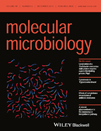- Submit a Protocol
- Receive Our Alerts
- Log in
- /
- Sign up
- My Bio Page
- Edit My Profile
- Change Password
- Log Out
- EN
- EN - English
- CN - 中文
- Protocols
- Articles and Issues
- For Authors
- About
- Become a Reviewer
- EN - English
- CN - 中文
- Home
- Protocols
- Articles and Issues
- For Authors
- About
- Become a Reviewer
A Filter Binding Assay to Quantify the Association of Cyclic di-GMP to Proteins
Published: Vol 5, Iss 3, Feb 5, 2015 DOI: 10.21769/BioProtoc.1394 Views: 11579
Reviewed by: Fanglian HeKanika Gera

Protocol Collections
Comprehensive collections of detailed, peer-reviewed protocols focusing on specific topics
Related protocols
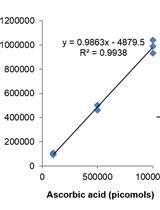
Measurement of Ascorbic Acid and Glutathione Content in Cyanobacterium Synechocystis sp. PCC 6803
Anabella Aguillera [...] María Victoria Martin
Oct 20, 2020 3898 Views
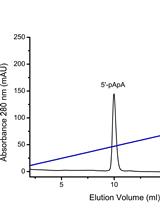
Assessment of Diadenylate Cyclase and c-di-AMP-phosphodiesterase Activities Using Thin-layer and Ion Exchange Chromatography
Andreas Latoscha [...] Natalia Tschowri
Jan 5, 2021 4161 Views
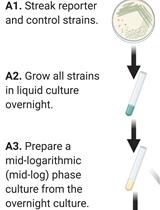
Analysis of Pseudomonas aeruginosa c-di-GMP High and Low Subpopulations Using Flow-assisted Cell Sorting (FACS) and Quantitative Reverse Transcriptase PCR (qRT-PCR)
Catherine R. Armbruster and Matthew R. Parsek
Jan 20, 2021 4710 Views
Abstract
Cyclic di-GMP (c-di-GMP) is a ubiquitous second messenger that regulates many processes in bacteria including biofilm formation, motility, and virulence (Hengge, 2009). Analysis of c-di-GMP binding properties of bacterial proteins is an important step to characterize c-di-GMP signaling pathways. C-di-GMP binds numerous proteins such as transcription factors, enzymes, and multimeric protein complexes (Hickman and Harwood, 2008, Ryjenkov et al., 2006, Weinhouse et al., 1997). The c-di-GMP binding assay described here is a relatively simple and cost effective method to characterize c-di-GMP binding to a protein using [32P]-labeled c-di-GMP. Radiolabeled c-di-GMP is readily synthesized with a purified GGDEF enzyme [such as WspR from Pseudomonas aeruginosa (P. aeruginosa)] and [32P]-GTP (Srivastava et al., 2013). After incubation of the labeled c-di-GMP with the protein of interest in solution, the resulting mixture is filtered through a nitrocellulose protein binding membrane. The amount of labeled c-di-GMP that is retained on the membrane indicates the interaction between the signal and protein. The specificity of c-di-GMP binding can be tested by competing with unlabeled c-di-GMP or other nucleotides such as GTP in the reaction. By examining binding of a fixed protein concentration to increasing concentrations of c-di-GMP, this method is able to determine the dissociation constant of c-di-GMP-protein interaction.
Keywords: Cyclic-di-GMPMaterials and Reagents
- Purified proteins to be tested
Note: Any kind of buffer can be used to prepare protein samples. We have tested this for sodium phosphate and Tris based buffers.
- [α-32P]-GTP (800 Ci/mmol, 10 mCi/ml, 250 µCi) (PerkinElmer, catalog number: BLU006X250UC )
- c-di-GMP unlabeled (Axxora)
- GTP (Sigma-Aldrich, catalog number: 51120 )
- Purified diguanylate cyclase [WspR (R242A mutant), P. aeruginosa (Sambanthamoorthy et al., 2012)]
- Antarctic phosphatase (New England Biolabs, catalog number: M0289S )
- Bovine serum albumin (BSA) (Sigma-Aldrich, catalog number: A9418 )
- Bradford reagent for protein concentration estimation (Bio-Rad Laboratories, catalog number: 500-0205 )
- Safety-SolveTM complete counting cocktail (RPI, catalog number: 111177 )
- Protein purification buffer (see Recipes)
- Binding buffer (see Recipes)
Equipment
- Nitrocellulose paper (0.2 µm) (Whatman, Optitran®, catalog number: BA-S 83 )
- Whatman filter paper (Whatman, catalog number: 3MM )
- Radioactive working area containing a centrifuge and heat block
- Scintillation vials (20 ml, with Poly screw caps, case of 500) (PerkinElmer, Econo Glass Vial, catalog number: 6000097)
- Scintillation counter (Beckman Coulter, model: LS 6500 )
- Biorad slot blot (Hybri Dot Manifold) (Bristol Robotics Laboratory, catalog number: 1050MM )
- 1.5 ml eppendorf tubes
- Filter tips
- Forceps and scissors
Software
- GraphPad Prism 5.0
Procedure
- Proteins to be tested are purified using the manufacturer’s instructions. We have used this assay to test binding to both 6x HIS tagged proteins (cloned and expressed from pET28b vectors) and untagged protein (cloned and expressed from pTXB1). Purified proteins are quantified using a Bradford assay (Bio-Rad Laboratories).
- A positive control protein that is known to bind to c-di-GMP such as YcgR from Escherichia coli should be included in the experiment. The purification of the positive control is performed similar to the test protein. BSA can be used as a negative control.
- Radiolabeled c-di-GMP is synthesized using a purified diguanylate cyclase enzyme with [α-32P]-GTP as a substrate. We have successfully used WspR (R242A mutant), a GGDEF protein from Pseudomonas aeruginosa for c-di-GMP synthesis (Sambanthamoorthy et al., 2012). The activity of the enzyme is tested as described (Hunter et al., 2014).
- Before starting the experiment, all buffers should be prepared and adjusted to the appropriate pH as described below.
- Synthesis of labeled c-di-GMP
- Thaw the [α-32P]-GTP.
- The reaction for c-di-GMP synthesis is set up as shown below:
*The activity of the enzyme is previously determined to assess the amount to be added.Constituent
Volume (µl)
NaCl (1 M)
2.05
Tris (1 M, pH 7.6)
1.2
MgCl2 (1 M)
0.25
[α-32P]-GTP or unlabeled GTP (12.5 µM)
42.5
WspR*
~100 μM
The total volume of the reaction is 50 µl.
- A reaction using unlabeled c-di-GMP is performed side by side to the reaction using labeled c-di-GMP for subsequent quantification of reaction efficiency.
- The reaction is incubated at room temperature overnight.
- 1 µl of Antarctic phosphatase (NEB) is added to the reaction to hydrolyze the leftover [α-32P]-GTP.
- The reaction is boiled for 10 min at 100 °C and precipitated protein is removing by centrifugation at 16,000 x g for 10 min at room temperature followed by removal of the supernatant.
- The reaction is transferred to another eppendorf tube and stored at -20 °C until further use.
- Thaw the [α-32P]-GTP.
- The concentration of c-di-GMP in the unlabeled control reaction is measured using ultra high-pressure liquid chromatography (UPLC)–tandem mass spectrometry (MS-MS) as previously described (Massie et al., 2012). The labeled reaction is assumed to be equivalent. Typically, the in vitro diguanylate cyclase reaction generates near 100% maximum yield based on the starting concentration of c-di-GMP.
- For binding reactions, 100 to 500 nM protein is incubated with varying amounts of [32P]-c-di-GMP (0.125 µM to 1.5 µM) in a 20 µl volume as shown below for 30 min at room temperature. The range of labeled c-di-GMP used is dependent on the particular binding parameters for the test protein. Each sample is tested in duplicate. Equivalent amounts of YcgR and BSA are included as positive and negative controls, respectively.
Constituent
Amount/Volume (µl)
Protein
100-500 nM
Binding buffer
5
[α-32P] c-di-GMP
0.125 µM to 1.5 µM
Water
Up to 20 µl
- As the binding reactions are incubating, the slot blot apparatus is prepared. A nitrocellulose membrane and whatman filter paper are cut to size of the dot blot assembly. The membrane and filter paper are immersed briefly in binding buffer to wet them. The dot blot apparatus is connected to vacuum and the membrane and filter paper are placed on the pore side with the vacuum turned on. The assembly is then completed by securely screwing in the top layer of the apparatus. This assures the correct vacuum sealing of the apparatus.
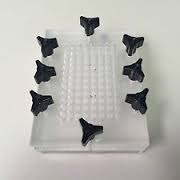
Figure 1. Hybri dot manifold assembly
- Preparations are then loaded onto a nitrocellulose membrane through a vacuum dot blot. The samples loaded on the dot blot should be well separated (one well on each side of sample well should be empty). The orientation of the blot should be marked before loading. This prevents contamination of counts during the processing step. After 5 min of sample loading, the sample wells are washed with 3 ml binding buffer (adding 200 µl of binding buffer at a time, 15 subsequent washes) in order to wash away unbound [32P]-c-di-GMP. The vacuum is kept on for 5 min after washing to dry the assembly out.
- The membrane is then removed from assembly and dried for 15 min on a dry filter paper, the spots containing sample are cut into square pieces and added to 5 ml scintillation fluid in a scintillation vial.
- The bound [32P]-c-di-GMP of individual wells is quantified by liquid scintillation counting (cpm/min).
- For competition experiments with unlabeled c-di-GMP and GTP, following incubation of the protein with [32P]-c-di-GMP for 15 min, 3 µM unlabeled nucleotides (unlabeled c-di-GMP and GTP) are added and the reaction is incubated for another 15 min and processed similarly.
- The data from the binding experiments is analyzed with GraphPad Prism 5.0 using non-linear regression analysis [a representative experiment is shown in Srivastava et al. (2013)].
Representative data
A representative experiment demonstrating c-di-GMP binding to V. cholerae transcription factor FlrA is shown in Srivastava et al. (2013).
Notes
- We have tested this protocol for transcription factors, which are mostly cytoplasmic proteins. But, in principle, this protocol should work for any bacterial proteins.
- To ensure that the Slot Blot assembly is securely tightened, use a dilute colored dye solution (such as Bromophenol Blue) to run through a few interspersed wells. The color should remain within the well and not spread out if the slot blot is sealed well and no bleed through is occurring between wells.
Recipes
- Protein purification buffer
As per the manufacturer’s directions
- Binding buffer
10 mM MgCl2
20 mM Tris (pH 7.8)
50 mM NaCl
Acknowledgments
This protocol was modified and adapted from a binding assay described previously (Hickman and Harwood, 2008).
References
- Hengge, R. (2009). Principles of c-di-GMP signalling in bacteria. Nat Rev Microbiol 7(4): 263-273.
- Hickman, J. W. and Harwood, C. S. (2008). Identification of FleQ from Pseudomonas aeruginosa as a c-di-GMP-responsive transcription factor. Mol Microbiol 69(2): 376-389.
- Hunter, J. L., Severin, G. B., Koestler, B. J. and Waters, C. M. (2014). The Vibrio cholerae diguanylate cyclase VCA0965 has an AGDEF active site and synthesizes cyclic di-GMP. BMC Microbiol 14: 22.
- Massie, J. P., Reynolds, E. L., Koestler, B. J., Cong, J. P., Agostoni, M. and Waters, C. M. (2012). Quantification of high-specificity cyclic diguanylate signaling. Proc Natl Acad Sci U S A 109(31): 12746-12751.
- Ryjenkov, D. A., Simm, R., Römling, U. and Gomelsky, M. (2006). The PilZ domain is a receptor for the second messenger c-di-GMP THE PilZ DOMAIN PROTEIN YcgR CONTROLS MOTILITY IN ENTEROBACTERIA. J Biol Chem 281(41): 30310-30314.
- Sambanthamoorthy, K., Sloup, R. E., Parashar, V., Smith, J. M., Kim, E. E., Semmelhack, M. F., Neiditch, M. B. and Waters, C. M. (2012). Identification of small molecules that antagonize diguanylate cyclase enzymes to inhibit biofilm formation. Antimicrob Agents Ch 56(10): 5202-5211.
- Srivastava, D., Hsieh, M. L., Khataokar, A., Neiditch, M. B. and Waters, C. M. (2013). Cyclic di-GMP inhibits Vibrio cholerae motility by repressing induction of transcription and inducing extracellular polysaccharide production. Mol Microbiol 90(6): 1262-1276.
- Weinhouse, H., Sapir, S., Amikam, D., Shilo, Y., Volman, G., Ohana, P. and Benziman, M. (1997). c-di-GMP-binding protein, a new factor regulating cellulose synthesis in Acetobacter xylinum. FEBS Lett 416(2): 207-211.
Article Information
Copyright
© 2015 The Authors; exclusive licensee Bio-protocol LLC.
How to cite
Srivastava, D. and Waters, C. M. (2015). A Filter Binding Assay to Quantify the Association of Cyclic di-GMP to Proteins. Bio-protocol 5(3): e1394. DOI: 10.21769/BioProtoc.1394.
Category
Microbiology > Microbial signaling > Secondary messenger
Do you have any questions about this protocol?
Post your question to gather feedback from the community. We will also invite the authors of this article to respond.
Share
Bluesky
X
Copy link


